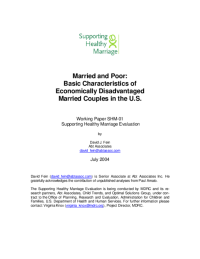Married and Poor
Basic Characteristics of Economically Disadvantaged Couples in the U.S.
The prisms social scientists have used to study marriage mostly have not been focused on the lower end of the economic spectrum. There has been considerable attention to racial and ethnic minorities and, more recently, to relationships among unwed parents. Although these populations are disproportionately poor, their distinctive attitudes and behaviors could reflect many influences other than economic status. Many analyses of marriage outcomes in the general population have included economic indicators as covariates. Very few, however, have examined carefully the effects of economic or other causal variables among the most disadvantaged sample members (Fein, 2003; Fein et al., 2003).
Emerging federal initiatives seeking to support marriage have increased the need for improved information on low-income married couples. These needs begin with basic descriptive statistics. Research on fragile families has demonstrated that simple facts can be very useful in stimulating thinking about interventions for couples. For example, the finding that a substantial majority of unwed couples are involved romantically around the time of birth but most of these relationships do not survive long after birth has stimulated interest in transition to parenthood programs (Dion et al., 2003). A similar body of descriptive evidence on low-income married couples is needed to support thinking about the broad population of interest, subgroups that might be particularly important to target, and the kinds of services and policy changes that may be most helpful.
One key need is to document the degree to which marriage outcomes vary across different forms and levels of economic disadvantage. Next, we must ascertain how different individual, family, and environmental characteristics of disadvantaged couples are associated with marriage outcomes. Beyond simple measures like marital satisfaction, it will be useful to assess how more specific aspects of marital interaction and related psychological processes — the proximate targets of relationship skills programs — vary across groups. Needed are analyses both of variation in outcomes at a point in time, as well as of changes in outcomes for a population over time.
This paper starts the enterprise by assembling and assessing recent descriptive statistics on the formation and stability, characteristics, and quality of marriages in the low-income population of the U.S. In addition to culling findings from published reports, it also provides new findings from several recent surveys.







